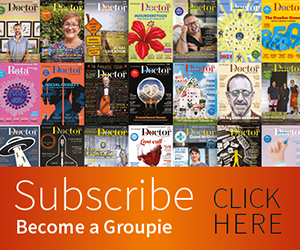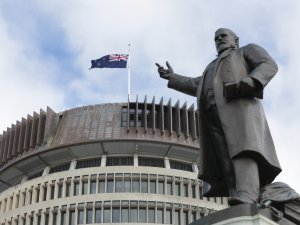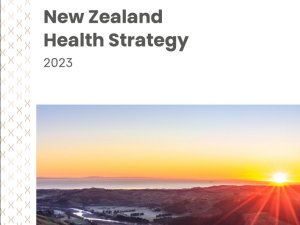Respiratory physician Lutz Beckert considers chronic obstructive pulmonary disease management, including the prevention of COPD, the importance of smoking cessation and pulmonary rehabilitation, and the lifesaving potential of addressing treatable traits. He also discusses the logic of inhaler therapy, moving from single therapy to dual and triple therapy when indicated, as well as other aspects of management
Get a move on and hold steady: Lack of details, direction in latest from ministry on hauora Māori
Get a move on and hold steady: Lack of details, direction in latest from ministry on hauora Māori

Gabrielle Baker struggles with reporting on feedback from meetings on a strategy – and tries to follow a thread
The Ministry of Health has released a slick-looking document, with lots of nice photos from four wānanga held across the country in February and March. The question is, why has this appeared now?
Dubbed Ngā Wānanga Pae Ora, it is a summary report on the engagement carried out by the ministry in developing Pae Tū, its hauora Māori strategy.
The Pae Tū strategy itself was released a few months back, in July, and is one of several required under the Pae Ora (Healthy Futures) Act 2022. The others include a New Zealand health strategy and Pacific health, health of disabled people, women’s health, and rural health strategies.
From the outset, I want to acknowledge that the term pae ora is used so often in the health sector it is hard to keep track of which of the different documents and strategies and legislation might be being referred to.
I absolutely do not support the frankly racist critique of the use of te reo Māori in the health sector (which I am only really aware of because I regularly read the FYI website and see some wild Official Information Act requests). But I am very wary of Māori terms becoming catchphrases and even “brands” for government agency activity.
In the case of Pae Tū, to paraphrase other commentators such as Workman Enterprises in their Pānui, all you can really say about it is that it exists. It meets the legislative requirement to have a strategy but doesn’t introduce anything new or set new directions.

The strategy essentially says, “Let’s hold steady until 2025, when we will do a proper review of our old Māori health strategy, He Korowai Oranga.”
The wānanga held earlier this year were a chance to talk about the hauora Māori strategy and share thoughts on what should be in the other strategies, and this report attempts to capture all of this. But I’m not exactly sure why it is being released now. The report could have made sense as a supplementary document to Pae Tū, back when it was released. But releasing a summary report on the engagement months after the actual strategy has been published seems a bit late.
It might have made sense if Ngā Wānanga Pae Ora set out a case for how the “hold steady” strategy was decided on. But it doesn’t really do that either. Although I found the report light on specifics, I read it as a call for greater and even accelerated change, not waiting two years to decide on anything.
As a participant in the engagement says in the report: “Kia tere! Get more runs on the board.”
Specifically, the report suggests participants sought a commitment to eliminating racism, doing commissioning differently and better, and stronger (and different) monitoring of health system performance. Pae Tū touches on these things, although not in a way that sets a clear direction for the future.
Ngā Wānanga Pae Ora also has short sections towards the end that capture feedback on the other health strategies. I was drawn immediately to the section on the health of disabled people strategy. And it’s here where the report becomes a bit questionable because it relies on what might broadly be called design thinking.
A tāngata whaikaha Māori persona named Kōwhai was developed for this part of the report. Personas are research-based characters that you create to understand the real experiences of people who will use your service or be affected by a policy. In this instance, it was created through “empathy mapping”, where people were asked to picture a loved one or group that fit the description of the focus population (presumably, identifies as having lived experience of disability), and visualise what they see, hear, feel, think, say and do about their health and wellbeing.
In my experience working in Māori health, personas are synonymous with stereotyping. I once walked out of a meeting in disgust where people were presenting personas of Māori women who smoked, which were like something written for Shortland Street on a bad day. It was a two-dimensional depiction presented as something insightful and revolutionary.
I’m not alone in this discomfort. Paula King, in her PhD on ethical co-design, looked at 17 co-design projects in Aotearoa me Te Waipounamu. Dr King described the personas in some of these projects as being used “to provide a ‘credible’ narrative of what was in fact colonial racialised discourse, through providing ‘experiential evidence’ that supported discriminatory stereotypes”.1
In articles titled “Personas” on digital.govt.nz and on the Department of the Prime Minister and Cabinet website, officials have acknowledged the possibility of personas being likened to stereotypes but assure us that, if proper methods are followed, it will all work out. This requires time, data, and research.
Because Ngā Wānanga Pae Ora doesn’t elaborate on how the persona of Kōwhai from Te Tai Tokerau was developed, it is hard to know whether these kinds of processes were followed. But the fact that the entire tāngata whaikaha Māori community is represented by one persona doesn’t provide much comfort.
Personas were originally designed to help understand the ideal or imagined customer. Government sources tend to advocate developing a series of service user personas for the likes of testing how your target customers would use your website to book an appointment. The resources don’t really talk about how personas will help you develop a strategy for a whole population.
One of the difficult things in critiquing a report that aims to summarise what people said is that it might look like I’m dismissing the voices of the 500 or more people who participated in the four wānanga.
I’m not. I just can’t quite tell what the report is trying to do.
The obvious thing is to say it is meant as a record that future policy-makers can consider in two years’ time when they’re revisiting He Korowai Oranga.
However, Ngā Wānanga Pae Ora is too light and lacking in detail to do this. So maybe the most important thing is that it is a record for participants?
If this is the case, my suggestion is that next time the report be a more complete summary of what was said by participants and less of a chance to show how some personas were sort of developed but maybe not used for anything (other than to rile me up!).
Gabrielle Baker (Ngāpuhi, Ngāti Kuri) is an independent health policy consultant
We're publishing this article as a FREE READ so it is FREE to read and EASY to share more widely. Please support us and our journalism – subscribe here
One of the benefits of subscribing is you will also be able to share your thoughts about what you read with other in our Comment Stream. You can also take notes on what you read with Capture






![Barbara Fountain, editor of New Zealand Doctor Rata Aotearoa, and Paul Hutchison, GP and senior medical clinician at Tāmaki Health [Image: Simon Maude]](/sites/default/files/styles/thumbnail_cropped_100/public/2025-03/Barbara%20Fountain%2C%20editor%20of%20New%20Zealand%20Doctor%20Rata%20Aotearoa%2C%20and%20Paul%20Hutchison%2C%20GP%20and%20senior%20medical%20clinician%20at%20T%C4%81maki%20Health%20CR%20Simon%20Maude.jpg?itok=-HbQ1EYA)
![Lori Peters, NP and advanced health improvement practitioner at Mahitahi Hauora, and Jasper Nacilla, NP at The Terrace Medical Centre in Wellington [Image: Simon Maude]](/sites/default/files/styles/thumbnail_cropped_100/public/2025-03/2.%20Lori%20Peters%2C%20NP%20and%20advanced%20HIP%20at%20Mahitahi%20Hauora%2C%20and%20Jasper%20Nacilla%2C%20NP%20at%20The%20Terrace%20Medical%20Centre%20in%20Wellington%20CR%20Simon%20Maude.jpg?itok=sUfbsSF1)
![Ministry of Social Development health and disability coordinator Liz Williams, regional health advisors Mary Mojel and Larah Takarangi, and health and disability coordinators Rebecca Staunton and Myint Than Htut [Image: Simon Maude]](/sites/default/files/styles/thumbnail_cropped_100/public/2025-03/3.%20Ministry%20of%20Social%20Development%27s%20Liz%20Williams%2C%20Mary%20Mojel%2C%20Larah%20Takarangi%2C%20Rebecca%20Staunton%20and%20Myint%20Than%20Htut%20CR%20Simon%20Maude.jpg?itok=9ceOujzC)
![Locum GP Helen Fisher, with Te Kuiti Medical Centre NP Bridget Woodney [Image: Simon Maude]](/sites/default/files/styles/thumbnail_cropped_100/public/2025-03/4.%20Locum%20GP%20Helen%20Fisher%2C%20with%20Te%20Kuiti%20Medical%20Centre%20NP%20Bridget%20Woodney%20CR%20Simon%20Maude.jpg?itok=TJeODetm)
![Ruby Faulkner, GPEP2, with David Small, GPEP3 from The Doctors Greenmeadows in Napier [Image: Simon Maude]](/sites/default/files/styles/thumbnail_cropped_100/public/2025-03/5.%20Ruby%20Faulkner%2C%20GPEP2%2C%20with%20David%20Small%2C%20GPEP3%20from%20The%20Doctors%20Greenmeadows%20in%20Napier%20CR%20Simon%20Maude.jpg?itok=B0u4wsIs)
![Rochelle Langton and Libby Thomas, marketing advisors at the Medical Protection Society [Image: Simon Maude]](/sites/default/files/styles/thumbnail_cropped_100/public/2025-03/6.%20Rochelle%20Langton%20and%20Libby%20Thomas%2C%20marketing%20advisors%20at%20the%20Medical%20Protection%20Society%20CR%20Simon%20Maude.jpg?itok=r52_Cf74)
![Specialist GP Lucy Gibberd, medical advisor at MPS, and Zara Bolam, urgent-care specialist at The Nest Health Centre in Inglewood [Image: Simon Maude]](/sites/default/files/styles/thumbnail_cropped_100/public/2025-03/7.%20Specialist%20GP%20Lucy%20Gibberd%2C%20medical%20advisor%20at%20MPS%2C%20and%20Zara%20Bolam%2C%20urgent-care%20specialist%20at%20The%20Nest%20Health%20Centre%20in%20Inglewood%20CR%20Simon%20Maude.jpg?itok=z8eVoBU3)
![Olivia Blackmore and Trudee Sharp, NPs at Gore Health Centre, and Gaylene Hastie, NP at Queenstown Medical Centre [Image: Simon Maude]](/sites/default/files/styles/thumbnail_cropped_100/public/2025-03/8.%20Olivia%20Blackmore%20and%20Trudee%20Sharp%2C%20NPs%20at%20Gore%20Health%20Centre%2C%20and%20Gaylene%20Hastie%2C%20NP%20at%20Queenstown%20Medical%20Centre%20CR%20Simon%20Maude.jpg?itok=Z6u9d0XH)
![Mary Toloa, specialist GP at Porirua and Union Community Health Service in Wellington, Mara Coler, clinical pharmacist at Tū Ora Compass Health, and Bhavna Mistry, specialist GP at Porirua and Union Community Health Service [Image: Simon Maude]](/sites/default/files/styles/thumbnail_cropped_100/public/2025-03/9.%20Mary%20Toloa%2C%20Porirua%20and%20Union%20Community%20Health%20Service%20in%20Wellington%2C%20Mara%20Coler%2C%20T%C5%AB%20Ora%20Compass%20Health%2C%20and%20Bhavna%20Mistry%2C%20PUCHS%20CR%20Simon%20Maude.jpg?itok=kpChr0cc)